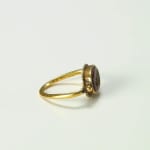Roman Ring Featuring a Carnelian Intaglio, 100 CE - 300 CE
Carnelian-Gold
FJ.6698
Both the Gold Setting and the Intaglio Seal are Ancient Roma The art of glyptics, or carving images on colored precious stones, is probably one of the oldest known to...
Both the Gold Setting and the Intaglio Seal are Ancient Roma
The art of glyptics, or carving images on colored precious stones, is probably one of the oldest known to humanity. Intaglios, gems with an incised design, were made as early as the fourth and third millennia B.C. in Mesopotamia and the Aegean Islands. They exhibit a virtuosity of execution that suggests an old and stable tradition rooted in the earliest centuries. The tools required for carving gems were simple: a wheel with a belt-drive and a set of drills. Abrasives were necessary since the minerals used were too hard for a metal edge. A special difficulty of engraving intaglios, aside from their miniature size, was that the master had to work with a mirror-image in mind.
This simple yet stunning ring might have once graced the finger of a Roman Empress or Priestess. The image of a female bust, perhaps a deity, has been expertly carved onto the face of this precious gemstone. This intaglio demonstrates the expertise of Ancient Roman glyptic artists. The elegant gold setting presents the seal without distracting from it. Wearing this ring, we wear a piece of the past. On our fingers, this ring radiates the same luxury and beauty that it would have on the hand of an Empress. How little times and tastes have changed over the years. Certain precious materials are as treasured today as they have been for thousands of years. Alas, this ancient ring speaks a vocabulary of wealth and opulence that needs no translation but is easily understood by all.
The art of glyptics, or carving images on colored precious stones, is probably one of the oldest known to humanity. Intaglios, gems with an incised design, were made as early as the fourth and third millennia B.C. in Mesopotamia and the Aegean Islands. They exhibit a virtuosity of execution that suggests an old and stable tradition rooted in the earliest centuries. The tools required for carving gems were simple: a wheel with a belt-drive and a set of drills. Abrasives were necessary since the minerals used were too hard for a metal edge. A special difficulty of engraving intaglios, aside from their miniature size, was that the master had to work with a mirror-image in mind.
This simple yet stunning ring might have once graced the finger of a Roman Empress or Priestess. The image of a female bust, perhaps a deity, has been expertly carved onto the face of this precious gemstone. This intaglio demonstrates the expertise of Ancient Roman glyptic artists. The elegant gold setting presents the seal without distracting from it. Wearing this ring, we wear a piece of the past. On our fingers, this ring radiates the same luxury and beauty that it would have on the hand of an Empress. How little times and tastes have changed over the years. Certain precious materials are as treasured today as they have been for thousands of years. Alas, this ancient ring speaks a vocabulary of wealth and opulence that needs no translation but is easily understood by all.



